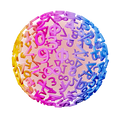What Are Linear Models?
You use a linear model when your points lie on an approximately straight line. Each set of points has its own unique best-fit model. Because there’s an infinite amount of ways to create a collection of points that can be modeled as a linear expression, there’s an infinite number of graphs that fit the expression below. The only difference between these graphs is the values of the slope and the constant term .
Theory
Linear Model
A linear function (straight line) is written like this:
In this expression, is the slope and is where the graph intersects the -axis.
When something increases or decreases by the same amount all the time, you have linear growth.
Linear regression is regression where you want to find the straight line that best fits a set of points. You will use digital tools for this. A plot for a linear regression will look like this:
The Linear Correlation Coefficient
For linear regression, you use the correlation coefficient as a measure of how well the function fits the points. The value varies from to , where
-
:
-
Perfectly adapted to the points, and the function increases as increases.
-
:
-
No correlation. The variables are linearly independent.
-
:
-
Perfectly adapted to the points, and the function decreases as increases.
This means that if we have , the regression matches the points perfectly, and if , there is no correlation between the points and the function. The larger is, the less the points deviate from the line. That means you want the largest possible —but that’s out of your control.





















